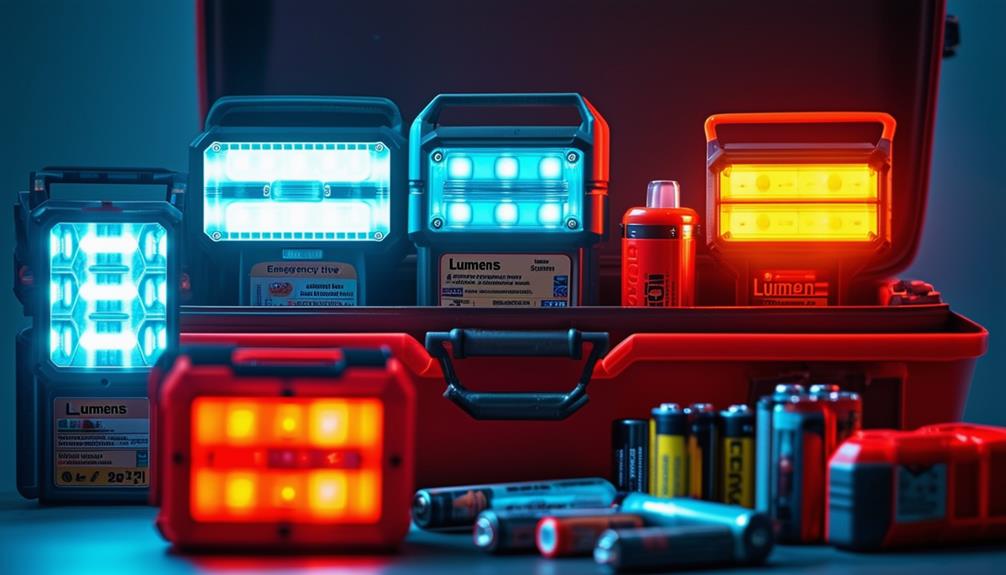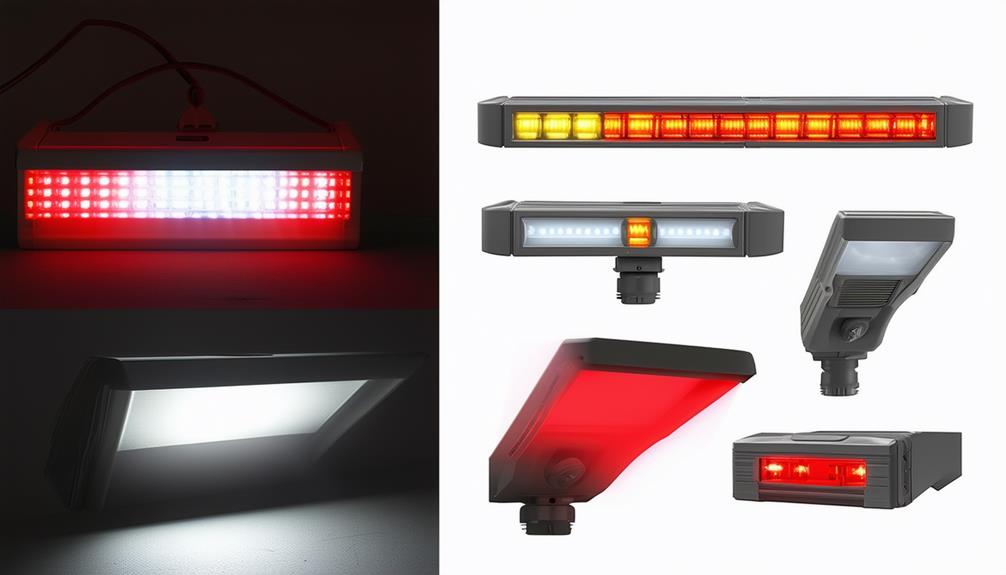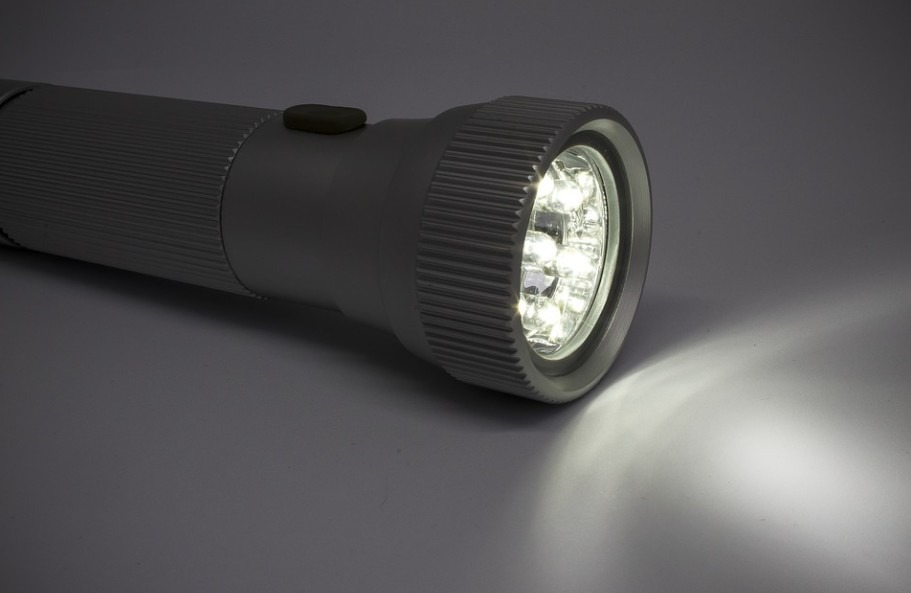Choosing the Right Lumens for Your Emergency Lights

Selecting the right lumens for your emergency lights is crucial for ensuring optimal brightness and safety. Lumens measure the total visible light output, and for emergency situations, a range of 200-600 lumens is recommended to ensure adequate illumination. This range not only enhances visibility but also allows you to effectively cover larger areas.
However, balancing lumens with other important factors like battery life and portability is essential. Understanding this balance is key to making the best choice for your needs. Let's explore how different considerations can influence your decision.
Understanding Lumens

Understanding lumens is crucial for ensuring sufficient brightness and visibility in emergency lighting. Lumens measure the total amount of visible light emitted from a source.
When selecting emergency lights, considering the number of lumens is essential. Higher lumens indicate brighter light output, which is vital during emergencies when visibility is compromised.
Typically, emergency lighting requires a minimum of 200-600 lumens to provide adequate brightness. This range ensures enough light to navigate safely and identify obstacles during power outages or other emergencies. By understanding lumens, you can determine the right level of illumination needed to maintain safety.
Selecting the appropriate lumens for your emergency lighting is about guaranteeing effective visibility, not just meeting a standard. If your environment requires more light, opting for a higher lumen count can make a significant difference. Conversely, for smaller areas, fewer lumens might suffice.
Ensuring you have the right lumens guarantees that your emergency lighting will function effectively when you need it most. Don't underestimate the importance of this measurement—your safety depends on it.
Power Source Options
Selecting the appropriate power source for your emergency lights ensures they are ready to function when you need them most. Here are the main options:
- Rechargeable Batteries: These lights commonly use lithium-ion batteries, known for their long-lasting power and extended use. They provide consistent lumen output, reducing the need for frequent battery changes. This option is both convenient and reliable during power outages.
- Disposable Batteries: These offer versatility and are ideal for quick replacements without the need for recharging. However, it's crucial to choose emergency lights that maintain continuous light output to avoid frequent battery swaps, ensuring reliable lumen output when needed.
Comparison of Power Source Options
| Power Source | Key Features |
|---|---|
| Rechargeable | Long-lasting, lithium-ion, convenient |
| Disposable | Versatile, quick replacement, no recharging |
Key Considerations
- Continuous Output: Ensure the emergency lights provide consistent lumen output for reliability.
- Battery Type: Consider lithium-ion for extended use and reliability.
Choosing the right power source is essential to guarantee your emergency lights are operational when needed. Whether you opt for rechargeable or disposable batteries, consider the lumen output and duration of light to ensure effectiveness during emergencies.
Battery Life Considerations

When evaluating emergency lights, prioritize battery life to ensure reliable illumination during prolonged outages. In emergencies, the dependability of your light source can significantly impact safety and comfort.
To be well-prepared, consider these three key factors:
- Extended Usage: Select emergency lights that provide up to 3 hours of continuous light per charge. This ensures you have sufficient time to address any unexpected situations during extended blackouts.
- Battery Type: Choose models with lithium-ion batteries for long-lasting power and reliability, especially in emergencies. These batteries also reduce the need for frequent replacements.
- Backup Options: Look for lights with disposable battery options. If the rechargeable battery fails, having a backup guarantees you won't be left in the dark.
Battery life is crucial for uninterrupted illumination, particularly when the duration of an outage is unknown. By focusing on these factors, you can ensure your emergency lights are always ready to provide dependable, long-lasting light in critical moments. Make a wise choice to maintain peace of mind during emergencies.
Brightness and Range
When selecting emergency lights, consider both lumens and beam distance to ensure sufficient visibility. Lights with 200-600 lumens and a beam distance of 20-50 meters provide effective coverage for safe navigation. Higher lumens indicate superior illumination, aiding in clear visibility during emergencies.
Lumens and Visibility
Understanding lumens is critical for ensuring your emergency lights provide adequate brightness and range for safe movement during power outages. Lumens measure the visible light output, and selecting the appropriate lumens per light is essential for effectively illuminating rooms, hallways, and staircases.
For most emergency situations, lights emitting between 200 to 600 lumens are recommended. This range ensures sufficient brightness for clear visibility and safe travel.
When choosing your emergency lights, consider the following factors:
- Safety: Higher lumens enhance visibility, reducing the risk of accidents during power outages.
- Comfort: Adequate brightness can alleviate stress and make navigating your home more comfortable.
- Preparedness: Proper lighting helps you stay prepared and confident during emergencies.
With higher lumens, your emergency lights can cover distances of 20 to 50 meters, allowing you to see obstacles and navigate your environment securely. Selecting the right lumens ensures you have the necessary brightness and range, providing optimal visibility when you need it most.
Understanding lumens and their impact on visibility is key to making informed decisions about your emergency lighting needs.
Beam Distance Coverage
Beam distance coverage is crucial for ensuring that emergency lights can effectively illuminate large areas during power outages. The distance your light can cover, typically ranging from 20 to 50 meters, directly impacts its utility in critical situations. Higher lumens significantly extend beam distance, thereby enhancing visibility in larger spaces, which is essential for household activities and safe navigation during emergencies.
To illustrate the relationship between beam distance and brightness, consider the following table:
| Lumens | Beam Distance (meters) |
|---|---|
| 100 | 20 |
| 300 | 35 |
| 500 | 50 |
Higher lumens lead to longer beam distances, making emergency lights more effective in covering extensive areas. This feature is particularly beneficial for activities such as trail running or tactical missions, where optimal performance is vital. However, it is also important to consider the correlation between beam distance and battery life. Higher lumens may reduce run times, so balancing these factors according to specific requirements is essential.
Versatile Lighting Modes

Emergency lights with adjustable lighting modes offer customizable brightness levels tailored to various needs. Whether you require a soft night light for comfort or a powerful beam to pierce through darkness, these versatile modes ensure preparedness for any situation. They provide the perfect brightness for every scenario, enhancing functionality and safety.
Emergency lights often feature multiple modes designed for different situations:
- Flashing Mode: Essential for signaling during emergencies, this mode attracts attention and can be lifesaving in critical moments.
- SOS Mode: Ideal for distress signaling, this mode uses a universal pattern to indicate a call for help, enhancing safety.
- Night Light Mode: Offers ambient lighting to create a calming atmosphere while ensuring visibility and safety at night.
These adaptable lighting modes make emergency lights highly functional, providing the appropriate illumination when needed most.
Investing in emergency lights with these features offers not just lighting but peace of mind. Ensure your emergency lights are equipped with versatile modes to adapt to any situation, without compromising on safety.
Size and Portability
When selecting emergency lights, consider their size and portability to ensure they meet your needs in various situations. The size should align with your intended use. For easy mobility, handheld lights offer excellent portability and are perfect for quickly checking around the house during power outages or other emergencies.
Handheld lights often come with handles or straps, providing hands-free convenience. This allows you to perform other tasks without having to constantly hold the light. Compact yet powerful models are versatile, fitting comfortably into small spaces while offering ample illumination. This makes them an ideal choice for those who need flexibility and convenience.
Portable emergency lights are also great for easy storage and quick access. You can keep them in a drawer, glove compartment, or any small space, ensuring they're always within reach when needed.
Installation and Maintenance

To ensure the effectiveness of your emergency lights, focus on proper installation techniques and establish a regular testing schedule. Routine inspections can identify potential issues early, mitigating safety hazards. Consistent maintenance ensures that your lights function correctly during power outages or emergencies.
Regular Testing Schedule
Establishing a regular testing schedule is crucial to ensure your emergency lights function properly during power outages or emergencies. A consistent testing routine guarantees your system operates reliably when needed most.
By testing your emergency lights at least once a month, you can detect and resolve potential issues before they escalate into serious problems. Regular maintenance and testing are essential for effective emergency lighting systems.
Here are three key reasons to adhere to a monthly testing schedule:
- Safety: Verify that your lights meet illumination requirements, ensuring everyone can safely evacuate during an emergency.
- Reliability: Routine checks help prevent unexpected failures, providing confidence that your emergency lights will perform as required.
- Compliance: Maintain adherence to local regulations and safety standards, avoiding potential fines or legal complications.
Proper Installation Techniques
Proper installation methods ensure your emergency lights provide optimal visibility and coverage during power outages or emergencies. Always install emergency lights at the recommended heights to illuminate critical areas effectively. Adhere closely to the manufacturer's guidelines to optimize performance and efficiency.
Position the lights strategically to cover escape routes, stairwells, and other key areas where visibility is crucial during an emergency. Ensure the lights are securely mounted, and all connections are properly insulated to prevent malfunctions.
Regularly test your emergency lights to confirm they function correctly. While routine inspections will be covered in more detail later, it's essential to validate your installation methods to ensure the lights activate as intended.
Maintaining your emergency lighting system is equally important. Proper maintenance prevents failures and ensures the lights are always ready when needed. By following these installation methods, you can trust that your emergency lights will perform reliably, keeping everyone safe during unforeseen events.
Routine System Inspections
Regularly inspecting your emergency lighting system ensures it's always ready to function when needed. These inspections are crucial for maintaining the safety of everyone in your building.
Focus on the following aspects:
- Proper Installation: Ensure all emergency lights are installed correctly with secure wiring and connections to prevent unforeseen failures.
- Battery Life: Frequently check the batteries to confirm they're holding a charge and ready for an emergency. Replace any batteries that show signs of weakness immediately.
- Light Output: Verify that each light emits the appropriate lumen output to ensure adequate lighting for guiding occupants to safety during an emergency.
Additionally, inspections should include checking the power supply and confirming that all components meet safety regulations to preempt any potential issues. Remember, a malfunction during an emergency can have severe consequences.
Regular maintenance isn't only about compliance; it also provides peace of mind. Knowing your emergency lights are functioning correctly assures you that you're safeguarding the safety of everyone in your building.
Conclusion
You've now gained the essential knowledge to select the right lumens for your emergency lights. For optimal safety and visibility, aim for a brightness range of 200-600 lumens.
Additionally, consider factors such as the power source, battery life, and versatile lighting modes to enhance effectiveness. Keep size and portability in mind for ease of use, and prioritize straightforward installation and maintenance. With these guidelines, you can confidently handle any emergency situation.




